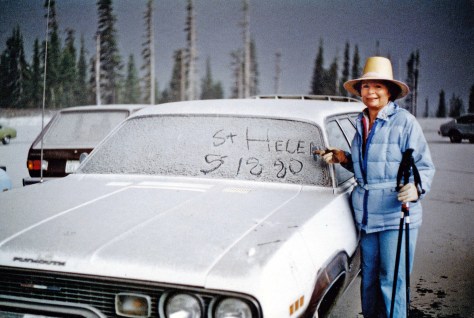(click and click again to enlarge photos)

(Published in the Seattle Times online and
in the PacificNW Magazine print edition on May 17, 2020)
Forty years later, the stories of St. Helens
unearth the wonder and dread of a lifetime
By Jean Sherrard and Clay Eals
In times of disaster, we all find comfort in telling – and retelling – our stories of survival and awe.
On Nov. 2, 2019, Jean drove to Mount St. Helens on a cloudless, sunny day to repeat a mid-1940s photo taken by postcard photographer Boyd Ellis from the shore of Spirit Lake, featuring the symmetrical cone of the mountain. Dozens of pickup trucks, surrounded by camo-wearing hunters, lined the roads. He’d arrived on the opening day of elk-hunting season.

Today, Spirit Lake is filled with debris from the May 18, 1980, eruption and still provides a mirror for the mountain. Yet the denuded landscape, while showing signs of recovery, remains an eerie reminder of the cataclysm.

For the past year, Alysa Adams, an interpretive specialist at the Mount St. Helens Visitor Center, has gathered personal accounts for the eruption’s 40th anniversary. She graciously offered to connect us with contributors.
Their collective voices (plus a few of our own solicitation) offer a deep reservoir of memories. In many instances, the event both shook and shaped their lives.
Here’s a sampling:
- As the mountain exploded just after 8:30 a.m., Jack Hughes, a ranger in Port Angeles, and Karen Weber in Bellingham both heard sharp retorts “like a cannon.”
- East of Wenatchee, 16-year-old Keith Bilodeau, fishing near Soap Lake, and Randy Brawley, working at Rock Island Dam, heard what sounded like shotgun blasts, as if, Brawley says, “someone was shooting pigeons.”
- In Vantage, along I-90 and the Columbia River, Cheryl Hargin says, “Day turned to night.”
- Near Packwood, between the peaks of Rainier and Adams, hiker John Killeen saw ash falling like “warm snow.”
- In Glenoma, five miles north of the “red zone,” Debbie King eyed “raining pumice stones … and a strong smell of sulfur.”
- In Moses Lake, Patti Mitchell viewed black clouds “ablaze with dry lightning” followed by a layer of ashes 5 inches deep.
- On his farm near Toutle, Bill Varner’s livestock panicked when the ash fell. “Cows and horses started running, scared to death. That was pretty wild.”
- Camping just 12 miles north of St. Helens, Kathleen Coleman narrowly escaped “boiling, purple-black clouds” rolling toward her like “a giant tidal wave.”
- In Corbett, Oregon, then-5-year-old Holly Garland got out of church and was amazed. She recollects, “There was ash everywhere, all over the cars. My dad yelled, ‘Don’t touch the car!’”
We also heard from Mark Smith, owner-operator of the Eco Park Resort, who suggested we contact his brother, Rob Smith, whose remarkable story is featured in this week’s cover story.
To read the 40 stories we received and view the many photos that accompany them, please visit our page “Forty stories for the 40th.”

(Click here to get back to our blog’s Mount St. Helens home page.)
